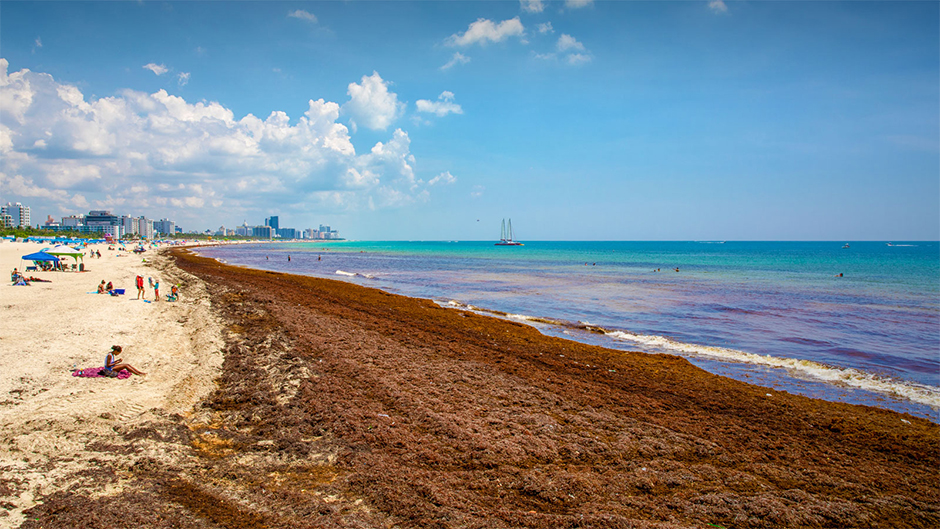It’s enough to fill about 3,000 Olympic-sized pools, and a good portion of it is headed our way.
A massive bloom of sargassum—that foul-smelling brown marine macroalgae that has invaded beaches across the Caribbean and along the east coast of Florida for the past few years—is growing in the Atlantic. January marked the second consecutive month that the amount of sargassum doubled, an ominous sign that the state’s beaches could be teeming with the malodorous stuff this summer.
In coastal waters, excessive amounts of sargassum can smother seagrass habitats, suffocate coral reefs, and harm fish. And when it decomposes on shore, the seaweed can also impact human health, producing toxic gases such as hydrogen sulfide and ammonia that can cause pulmonary, neurological, and cardiovascular lesions.
Local municipalities spend millions of dollars hauling sargassum away to landfills, wasting a renewable resource.
But now, a University of Miami College of Engineering researcher and her graduate assistant have demonstrated that sargassum can be used to make an effective compost—a mixture of organic matter used as plant fertilizer.
“The amount of seaweed on our beach shores will only increase as our climate continues to change,” said Helena Solo-Gabriele, professor of environmental engineering. “It’s becoming increasingly important that we seek out solutions that convert sargassum for beneficial uses, and composting is a viable alternative to just hauling it away in dump trucks to landfills.”
As part of the two-year study, “Evaluating Compost as a Means to Recycle Sargassum Macroalgae,” doctoral student Afeefa Abdool-Ghany, who is mentored by Solo-Gabriele, used two methods to produce compost from sargassum. In the first, she placed sargassum samples prepared in four different techniques (washed, unwashed, unwashed mixed with green yard waste, and unwashed mixed with woody yard waste) into individual compartments of two small tumbler composts.
In the second phase, a collaboration with the City of Hallandale Beach, samples of unwashed sargassum as well as unwashed sargassum mixed with vegetative waste were placed in large compost piles. The study was funded by the Hinkley Center for Solid and Hazardous Waste Management.
“We measured the seaweed for bacteria. Because from a previous study on sargassum, we saw that there were high levels of bacteria in the seaweed as it decomposes,” Abdool-Ghany said. “We also monitored for metals and for basic physiochemical parameters such as pH and temperature. And we looked at nutrients such as carbon-to-nitrogen ratios.”
While the first method produced compost that had levels of bacteria that were was not within standards established by the U.S. Composting Council, the second technique that involved large compost piles did result in compost that met acceptable standards for bacteria.
Peter Swart and Amanda Oehlert, marine geoscientists at the Rosenstiel School of Marine, Atmospheric, and Earth Science, analyzed the nutrients, metals, and phosphorous in the compost. Trent Blare, an assistant professor of food and resource economics at the University of Florida, also participated in the study, providing expertise in the economics of composting.
“We proved that sargassum can be composted and that it can create a compost product,” said Abdool-Ghany, noting the radishes they grew in the compost. “But there are limitations that must be addressed.”
One of those limitations is the presence of arsenic in the compost they produced. “The compost produced is an economically viable product. It turns into soil, and you can grow plants with it,” Solo-Gabriele said. “But because of the arsenic levels, we don’t recommend that it be used for growing crops that you eat. But for fill and for other purposes, it’s a good material.”
She and Afeefa have a grant pending for a study that will examine why arsenic is present in sargassum. “We need to get a better understanding of whether or not the sargassum is contributing to the arsenic,” Solo-Gabriele said. “And that process will start on the beach.”

